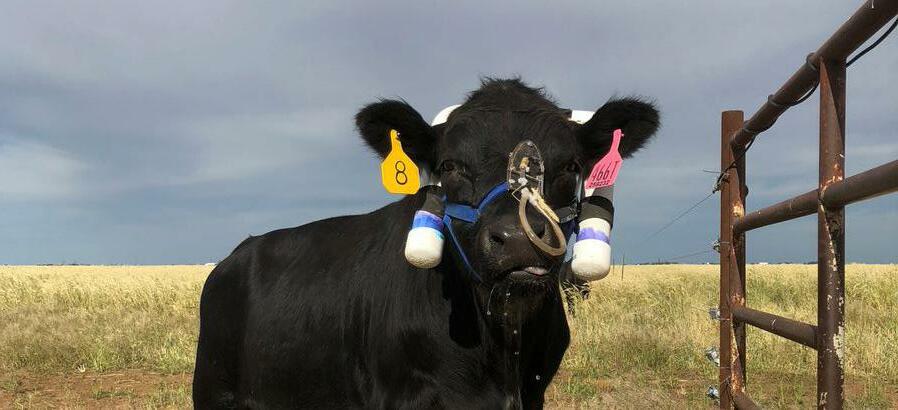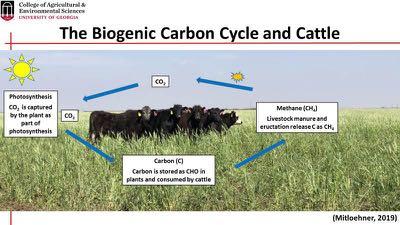
4 minute read
Better Burps: Cattle’s Role in Sustainable Protein Production By Dr. Darren Henry, Assistant Professor, Dept. of Animal & Dairy Science, University of Georgia
Better Burps: Better Burps:
Cattle’s Role in Sustainable Protein Production
Advertisement
By Dr. Darren Henry, Assistant Professor, Animal & Dairy Science Dept., University of Georgia
It is not difficult to find somebody talking about methane (CH4) these days. Simply turn on the TV, open your computers to your news affiliate of choice, or log into most any social media platform. Everyone has an opinion about CH4, and that is one of the main problems: It is an opinion. Over and over, we have been told that CH4 is a potent greenhouse gas and it contributes to global warming – and since ruminants (i.e., cattle) produce CH4, they are destroying the world! I am here to tell you that all of that is true – other than the last bit about destroying the world. On the contrary, cattle have a role in actually cooling the earth’s atmosphere.
It is true that cattle produce CH4; the average beef cow (whatever that is) can produce between 0.1 to 0.2 pounds of CH4 every day. This is a natural process that allows the animal to control the pH of their rumen by removing hydrogen (an element that impacts acidity). Methane is a very potent greenhouse gas, and we do need to do our part as humans to try and reduce the amount of CH4 produced; however, unlike carbon dioxide (CO2), which is in the atmosphere for approximately 1,000 years, CH4 has an atmospheric lifespan of only 12 years – after which, CH4 is converted to CO2.
The other element that makes up CH4 is carbon. Let’s consider where this carbon is coming from: the diet, whether that be forage, supplement, or a total mixed ration. For the most part, our cattle are consuming plants, either as forage, as grain, or

as byproducts. Now, let’s think back to fifth-grade science class and remember how plants are able to grow. Through a process called photosynthesis, plants pull CO2 from the atmosphere and peel off the oxygen (O2), and they use the carbon to produce energy for plant growth. What this means is that the CH4 produced from the rumen of cattle is formed from CO2 that could have previously been CH4 from the rumen of a grazing beef cow. This is the cycle of Biogenic Carbon.
If we consider that the CH4 produced from the U.S. beef herd is biogenic and that this carbon is consistently being recycled through the system via grasslands and grain, the story we should be hearing is this: Cattle are not actually an enormous source of greenhouse gases; instead, they can actually act as a source of carbon sequestration and short-term global cooling. Today, if the global cattle herd does not grow in number of head, the amount of carbon released (i.e., CH4) and sequestered (i.e., CO2 taken into soils and plants) is in balance. This is great news! What is even better news is that if we utilize novel technologies, such as feed additives, we have the opportunity to release less CH4, which would lead to short-term cooling.
As producers, many of us may ask the obvious question: “if we are currently not significantly contributing to global warming with our cows, why would I want to spend more money to reduce CH4?” The answer to that is efficiency. When cattle produce CH4, they do that at a cost – and that cost is energy. Approximately 2-12 percent of the energy consumed by cattle is lost as CH4, with cattle consuming forage-based diets producing 3-4 times more CH4 than their grain-fed counterparts. Therefore, by mitigating the release of CH4 from ruminants, the opportunity arises for that carbon to go into meat, milk or fiber production.
Today, several faculty members in the Department of Animal and Dairy Science are working together to develop breeding, management and nutritional strategies that can reduce the emissions of cattle in the Southeast and globally. Together, we are working with national and regional commodity groups, industry leaders, and fellow scientists from other departments and universities to ensure that the next generation of beef producers will not have to worry about this particular problem any longer. Some new equipment additions to the department will allow for further investigation into diurnal patterns of CH4 emissions, feed intake, and soil and manure emissions.
It is important for us to consider these aspects of CH4 production. It is easy for many of us to scoff every time we hear someone speak about the CH4 produced by cattle; however, maybe it is time for us to consider that the story we need to be telling is this: We have the ability to cool the planet with cattle while saving on our feed bill.











